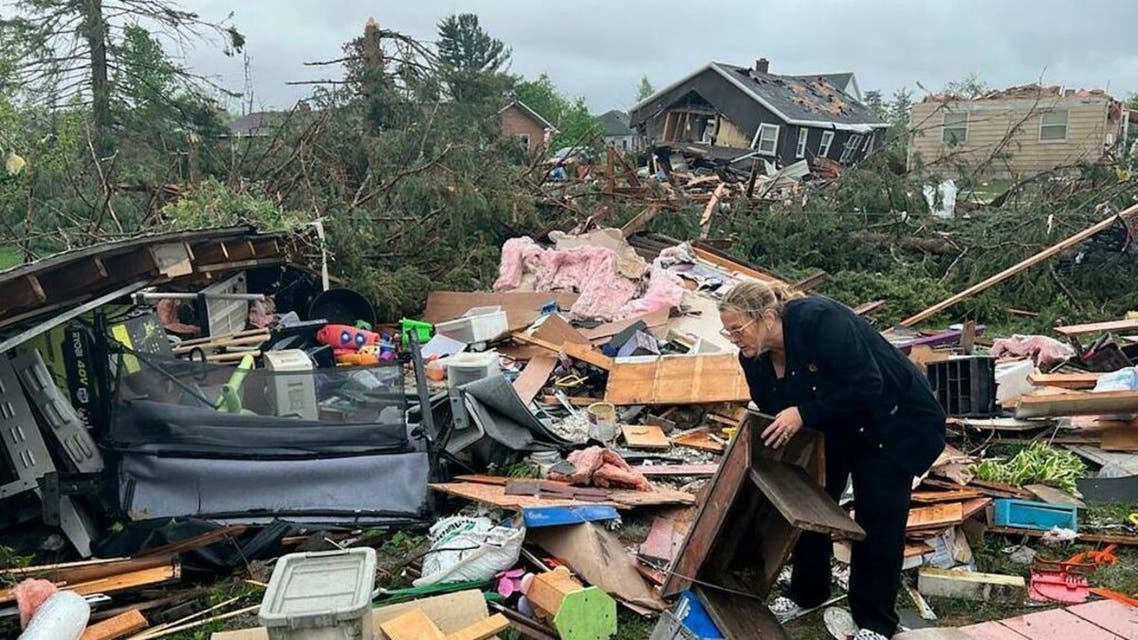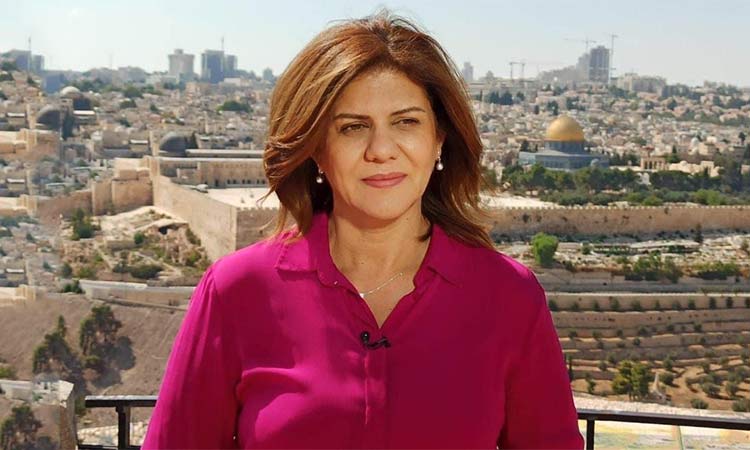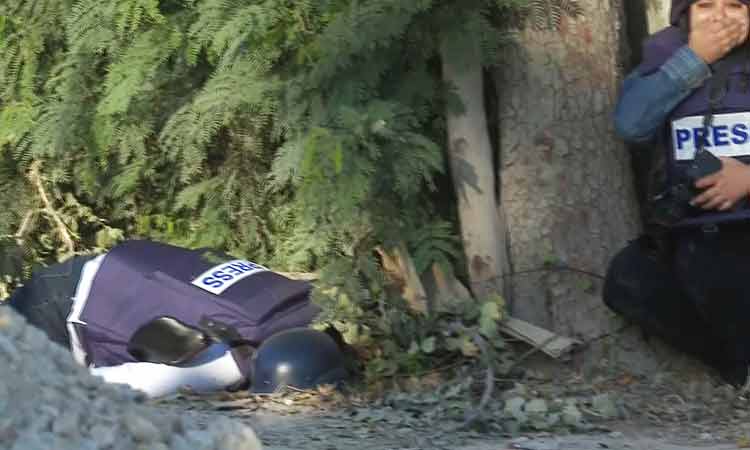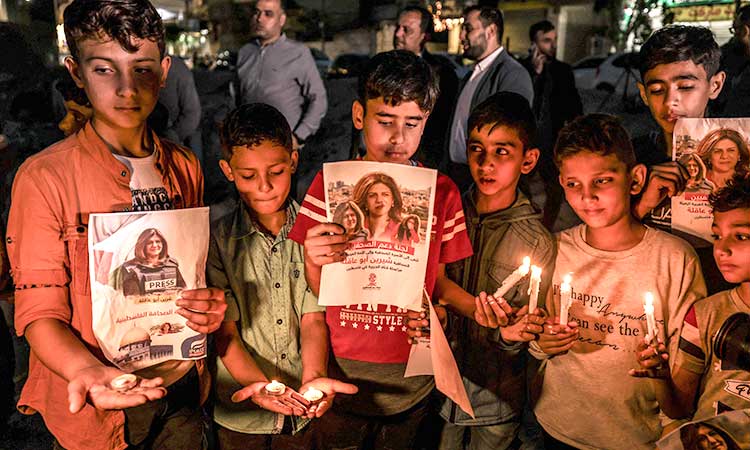
A rare northern Michigan tornado tore through a small community on Friday, killing at least one person and injuring more than 40 others as it flipped vehicles, tore roofs from buildings and downed trees and power lines. (Twitter)
The Associated Press
Published: 21 May ,2022
A rare northern Michigan tornado tore through a small community on Friday, killing at least one person and injuring more than 40 others as it flipped vehicles, tore roofs from buildings and downed trees and power lines.
The twister hit Gaylord, a city of about 4,200 people roughly 230 miles (370 kilometers) northwest of Detroit, at around 3:45 p.m.
Mike Klepadlo, who owns the car repair shop Alter-Start North, said he and his workers took cover in a bathroom.
“I’m lucky I’m alive. It blew the back off the building,” he said. “Twenty feet (6 meters) of the back wall is gone. The whole roof is missing. At least half the building is still here. It’s bad.”
Emma Goddard, 15, said she was working at the Tropical Smoothie Cafe when she got a phone alert about the tornado. Thinking the weather outside looked “stormy, but not scary,” she dismissed it and returned to what she was doing. Her mother then called and she assured her mom she was OK.
Two minutes later, she was pouring a customer's smoothie when her coworker's mom rushed in yelling for them to get to the back of the building, Goddard told The Associated Press by text message.
They took shelter in the walk-in cooler, where they could hear windows shattering.
“I was crammed shoulder-to-shoulder with my seven co-workers, two of my co-workers’ parents and a lady from Door Dash coming to pick up her smoothies.”
When they left the cooler about 15 minutes later and stepped outside, they saw "some of our cars in pieces and insulation all over the ground,” Goddard said. Three neighboring businesses were destroyed, she said.
Brian Lawson, a spokesman for Munson Healthcare, said Otsego Memorial Hospital was treating 23 people injured by the tornado and that one person was killed. He didn’t know the conditions of the injured or the name of the person who died.
The Michigan State Patrol confirmed that one person was killed, saying in a tweet that more than 40 others were hurt and being treated at area hospitals. The patrol planned to hold a briefing Saturday morning.
“I’ve never seen anything like this in my life,” Mayor Todd Sharrard said. “I'm numb.”
Video posted online showed a dark funnel cloud materialize out of a cloud as nervous drivers looked on or slowly drove away, uncertain of its path.
Other video showed extensive damage along the city’s Main Street. One building appeared to be largely collapsed and a Goodwill store was badly damaged.
A collapsed utility pole lay on the side of the road, and debris, including what appeared to be electrical wires and parts of a Marathon gas station, was scattered all along the street.
The Red Cross set up a shelter at a church.
Brandie Slough, 42, said she and a teen daughter sought safety in a restroom at a Culver’s. Windows of the fast food restaurant were blown out when they emerged, and her pickup truck had been flipped on its roof in the parking lot.
“We shook our heads in disbelief but are thankful to be safe. At that point, who cares about the truck,” Slough said.
Eddie Thrasher, 55, said he was sitting in his car outside an auto parts store when the tornado seemed to appear above him.
“There are roofs ripped off businesses, a row of industrial-type warehouses,” Thrasher said. “RVs were flipped upside down and destroyed. There were a lot of emergency vehicles heading from the east side of town.”
He said he ran into the store to ride it out.
“My adrenaline was going like crazy,” Thrasher said. “In less than five minutes it was over.”
Extreme winds are uncommon in this part of Michigan because the Great Lakes suck energy out of storms, especially early in spring when the lakes are very cold, said Jim Keysor, a Gaylord-based meteorologist with the National Weather Service.
“Many kids and young adults would have never experienced any direct severe weather if they had lived in Gaylord their entire lives,” he said.
The last time Gaylord had a severe wind storm was in 1998, when straight-line winds reached 100 miles per hour, Keysor said. He said the conditions that spawned Friday’s twister included a cold front moving in from Wisconsin and hitting hot and humid air over Gaylord, with the added ingredient of turning winds in the lower part of the atmosphere.
Gov. Gretchen Whitmer declared a state of emergency for Otsego County, making further state resources available to the county.
Gaylord, known as the “Alpine Village,” is set to celebrate its 100th birthday this year, with a centennial celebration that will include a parade and open house at City Hall later this summer.
The community also holds the annual Alpenfest in July, an Alpine-inspired celebration honoring the city’s heritage and a partnership with a sister city in Switzerland.
Read more:
Sandstorm blankets Saudi Arabia’s capital Riyadh
California warns of possible summer blackouts as power runs low
Flash floods kill at least 18 in Afghanistan: Official
Michigan tornado killed 2, injured dozens, state police say

A tornado caused damage throughout the business district of Gaylor, Mich., emergency officials said.
May 21 (UPI) -- A tornado that tore through northern Michigan killed two people and injured dozens others, state police said.
Michigan State Police said two people died and 23 injured people were being treated at Gaylord-Otsego Memorial Hospital, according to the Detroit Free Press. Gaylord Mayor Todd Sharrard said an estimated 35 to 40 people sought treatment at area hospitals, according to WPBN-TV in Traverse City.
The twister touched down in the city of Gaylord Friday afternoon, causing heavy damage. Thousands of people lost power, with 6,500 customers still without electricity Saturday morning.
Gov. Gretchen Whitmer declared a state of emergency for Otsego County in the wake of the storm, diverting resources to the affected region and activating the State Emergency Operations Center.
"My heart goes out to the families and small businesses impacted by the tornado and severe weather in Gaylord," she said in a statement.
"Our state is grateful for the first responders and utility workers who are working hard to keep everyone safe. Michiganders are tough. We are resilient. And there's no challenge we can't get through together."
The National Weather Service said the tornado initially touched down southwest of Gaylord and moved to the northeast.
"For northern Michigan, it will likely be a fairly long, damaged path," NWS meteorologist Jim Keysor said.
It would be long if you "were in tornado alley in the Plains, but for northern Michigan where we don't receive very many tornadoes, it's a fairly long path."
Damaging tornado tears through northern Michigan
By John Murphy, AccuWeather, Accuweather.com
MAY 20, 2022

AccuWeather radar imagery of northern Michigan when the tornado was reported in Gaylord, Mich.
Heavy damage has been reported in Gaylord, Mich., after a large and extremely dangerous tornado was spotted in the area.
A tornado warning was initially issued at 3:38 p.m. for Antrim and Otsego counties in Michigan, which included the city of Gaylord.
About 10 minutes later, the tornado warning for Otsego County was updated to note a confirmed large and extremely dangerous tornado, which was deemed an emergency situation, according to the National Weather Service.
At 3:48 pm, the tornado was spotted by a National Weather Service employee near the intersection of Michigan 32 and Murner Road, about 2 miles west of Gaylord. About 5 minutes later, the tornado was spotted again about 1 mile east of Gaylord.
Frank McClellan was sitting at Taco Bell in Gaylord when he witnessed the tornado come through the city.
"I was sitting in the Taco Bell, right there on (Michigan 32), and the funnel cloud came right down 32 and for some reason took a turn in the Taco Bell parking lot and hit all the buildings behind us and leveled a bunch of them," Frank McClellan told WWJ's Sandra McNeill.
McClellan told WWJ that he heard explosions coming their way but remarkably, the tornado did not hit where they were standing inside the Taco Bell.
Little Caesars Pizza in Gaylord was one of the buildings damaged from the storm, with photos posted on Twitter showing missing walls and debris scattered around.
Following the tornado, the Otsego County scanner had reports of gas leaks, damaged homes and injuries. Multiple businesses in the area were said to have sustained heavy damage, according to WLNS-TV meteorologist Blake Harms.
The Michigan State Police added that in addition to structural damage, trees and power lines were blocking roadways, warning people to avoid the Gaylord area as emergency crews responded.
Debris was also thrown onto nearby roads, including onto Michigan 32, according to the Michigan Department of Transportation.
Photos of the damage posted on Twitter showed portions of roofs on homes torn off and trailers stacked on top of each other in a pile of rubble. More than 6,000 customers were without power in Otesgo county as of 4 p.m., according to PowerOutage.us.
Interstate 75 in Michigan was closed both directions in Gaylord due to debris, according to WNEM-TV.
The last tornado to impact near Gaylord was in 2014, when two EF1 tornadoes carved a path about 15 miles south and southeast of the city, according to Tornado Archive.
Key points:
Along with one person confirmed dead, 40 other people have been hospitalised with injuries
Extreme winds are uncommon in this part of Michigan, especially in early Spring
The twister hit Gaylord, a city of about 4,200 people roughly 370 kilometres north-west of Detroit, at around 3:45pm.
Mike Klepadlo, who owns the car-repair shop Alter-Start North, said he and his workers took cover in a bathroom.
"I'm lucky I'm alive. It blew the back off the building," he said.
"Twenty feet [6 meters] of the back wall is gone. The whole roof is missing. At least half the building is still here. It's bad."
Emma Goddard, 15, said she was working at the Tropical Smoothie Cafe when she got a phone alert about the tornado.
Thinking the weather outside looked "stormy, but not scary," she dismissed it and returned to what she was doing. Her mother then called and she assured her mom she was OK.
Two minutes later, she was pouring a customer's smoothie when her coworker's mother rushed in yelling for them to get to the back of the building, Ms Goddard told The Associated Press by text message.
They took shelter in the walk-in cooler, where they could hear windows shattering.
"I was crammed shoulder-to-shoulder with my seven coworkers, two of my coworkers' parents and a lady from Door Dash coming to pick up her smoothies."
When they left the cooler about 15 minutes later and stepped outside, they saw "some of our cars in pieces and insulation all over the ground," Ms Goddard said. Three neighbouring businesses were destroyed, she said.
Brian Lawson, a spokesman for Munson Healthcare, said Otsego Memorial Hospital was treating 23 people injured by the tornado and that one person was killed. He didn't know the conditions of the injured or the name of the person who died.
The Michigan State Patrol confirmed that one person was killed, saying in a tweet that more than 40 others were hurt and being treated at area hospitals. The patrol planned to hold a briefing Saturday morning.
"I've never seen anything like this in my life," Mayor Todd Sharrard said. "I'm numb."
Video posted online showed a dark funnel cloud materialise out of a cloud as nervous drivers looked on or slowly drove away, uncertain of its path.
Other video showed extensive damage along the city's Main Street. One building appeared to be largely collapsed and a Goodwill store was badly damaged.
A collapsed utility pole lay on the side of the road, and debris, including what appeared to be electrical wires and parts of a Marathon gas station, was scattered all along the street.
The Red Cross set up a shelter at a church.
Brandie Slough, 42, said she and a teen daughter sought safety in a rest room at a Culver's. Windows of the fast-food restaurant were blown out when they emerged, and her pick-up truck had been flipped on its roof in the parking lot.
"We shook our heads in disbelief but are thankful to be safe. At that point, who cares about the truck," Ms Slough said.
Eddie Thrasher, 55, said he was sitting in his car outside an auto-parts store when the tornado seemed to appear above him.
"There are roofs ripped off businesses, a row of industrial-type warehouses," Mr Thrasher said.
"RVs were flipped upside down and destroyed. There were a lot of emergency vehicles heading from the east side of town."
He said he ran into the store to ride it out.
"My adrenaline was going like crazy," Mr Thrasher said. "In less than five minutes it was over."
Extreme winds are uncommon in this part of Michigan because the Great Lakes suck energy out of storms, especially early in spring when the lakes are very cold, said Jim Keysor, a Gaylord-based meteorologist with the National Weather Service.
"Many kids and young adults would have never experienced any direct severe weather if they had lived in Gaylord their entire lives," he said.
The last time Gaylord had a severe wind storm was in 1998, when straight-line winds reached 100mph, Mr Keysor said.
He said the conditions that spawned Friday's twister included a cold front moving in from Wisconsin and hitting hot and humid air over Gaylord, with the added ingredient of turning winds in the lower part of the atmosphere.
Governor Gretchen Whitmer declared a state of emergency for Otsego County, making further state resources available to the county.
Tornado touches down in German city, 43 injuries reported

People clear debris from a street in Paderborn, Germany, on Saturday after a tornado carved out a swath of destruction in the eastern part of the state of North Rhine-Westphalia. Police said 43 people were injured in Paderborn.
May 21 (UPI) -- Police in Germany said 43 people were injured by a tornado that swept through a city amid a severe thunderstorm.
Police in the western city of Paderborn said the tornado ripped the roofs from buildings on Friday and debris was spread across several miles.
Paderborn police said in a Facebook post that 43 people were injured by the tornado, 10 of them severely. One woman suffered life-threatening injuries, police said.
The German Weather Service confirmed tornadoes were also spotted in nearby Lippstadt just outside the town of Hoexter.
Police said cleanup operations were underway Saturday in Paderborn, with drivers urged to avoid the most heavily-affected areas and pedestrians were warned of numerous dangers from the tornado debris.
By Associated Press
May 21, 2022

BERLIN — A storm that swept across parts of Germany generated three tornadoes, the country’s weather service said Saturday. More than 40 people were injured in one western city.
Meteorologists had warned of heavy rainfall, hail and strong gusts of wind in western and central Germany on Friday, and people in the western state of North Rhine-Westphalia were advised to stay home. Storms on Thursday had already disrupted traffic, uprooted trees that toppled onto rail tracks and roads, and flooded hundreds of basements in western Germany.
The German Weather Service confirmed three tornadoes in North Rhine-Westphalia — in Paderborn, in nearby Lippstadt, and on the edge of the town of Hoexter, news agency dpa reported.
Police in Paderborn said that 43 people were injured there, 30 of whom were taken to hospitals. The storm loosened roof tiles, brought down scaffolding, overturned cars and sent tree branches crashing into windows.
Further south, authorities in Bavaria said 14 people were injured Friday when the wooden hut they were trying to shelter in collapsed during a storm at Lake Brombach, south of Nuremberg.





















